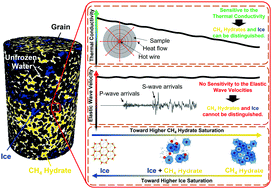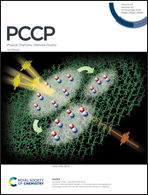Development of a coupled geophysical–geothermal scheme for quantification of hydrates in gas hydrate-bearing permafrost sediments†
Abstract
Quantification of hydrates in permafrost sediments using conventional seismic techniques has always been a major challenge in the study of the climate-driven evolution of gas hydrate-bearing permafrost sediments due to almost identical acoustic properties of hydrates and ice. In this article, a coupled geophysical–geothermal scheme is developed, for the first time, to predict hydrate saturation in gas hydrate-bearing permafrost sediments by utilising their geophysical and geothermal responses. The scheme includes a geophysical part which interprets the measured elastic wave velocities using a rock-physics model, coupled with a geothermal part, interpreting the measured effective thermal conductivity (ETC) using a new pore-scale model. By conducting a series of sensitivity analyses, it is shown that the ETC model is able to incorporate the effect of the hydrate pore-scale habit and hydrate/ice-forced heave as well as the effect of unfrozen water saturation under frozen conditions. Given that the geophysical and geothermal responses depend on the overburden pressure, the elastic wave velocities and ETC of methane hydrate-bearing permafrost sediment samples were measured at different effective overburden pressures and the results were provided. These experimental data together with the results of our recent study on the geophysical and geothermal responses of gas hydrate-bearing permafrost sediment samples at different hydrate saturations are used to validate the performance of the coupled scheme. By comparing the predicted saturations with those obtained experimentally, it is shown that the coupled scheme is able to quantify the saturation of the co-existing phases with an acceptable accuracy in a wide range of hydrate saturations and at different overburden pressures.



 Please wait while we load your content...
Please wait while we load your content...